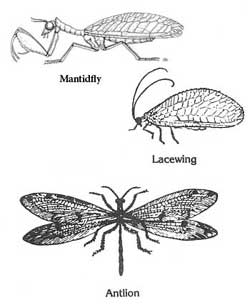Neuroptera: Lacewings, Antlions, others
(from the Greek: neura = nerves + ptera = wings)
Neuroptera have chewing mouthparts, long antennae, and 2 pairs of membranous wings with many cross veins. A key feature separating Neuroptera from closely related Megaloptera is the forked veins along the wing margins in Neuroptera. Metamorphosis is complete. Most members of this order are small- to medium-sized. Members of this order are parasitic or predaceous on other invertebrates. Antlions are well-known members of this group. The larvae, called “doodlebugs,” catch insects at the bottom of pits that they construct in sandy soil. Adult antlions resemble damselflies, but have longer antennae. Other common Neuroptera include: owlflies, mantidflies, dobsonflies, and lacewings. Owlflies resemble antlions but have longer antennae and a shorter body. The mantidflies resemble miniature praying mantids. The green lacewing is a common representative of this order and is a beneficial insect in all of its life stages because it destroys aphids. The larva of the green lacewing is commonly called the “aphid lion.”
Note: Some keys place dobsonflies, alderflies, and fishflies (order Megaloptera) into Neuroptera. For Florida 4-H judging purposes, these groups are separate, but other states may combine them.

